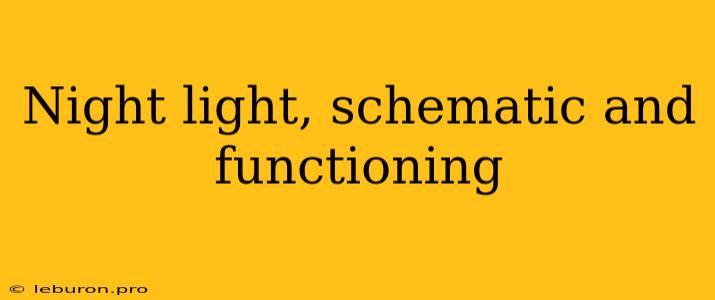Illuminating the Night: Understanding Night Light Schematics and Functioning
Night lights, those small, comforting sources of illumination that chase away the shadows of the night, are often taken for granted. However, behind their simple appearance lies a fascinating interplay of electrical components working in harmony. Understanding the schematic and functioning of a night light allows us to appreciate its design and the clever engineering that makes it possible.
This article will delve into the world of night lights, exploring the different types, their electrical schematics, and how these components work together to provide that gentle glow. We will also discuss the safety considerations and potential applications of these seemingly simple yet indispensable devices.
Types of Night Lights
Night lights come in a variety of designs, each with its own unique features and applications. Here are some common types:
1. Plug-in Night Lights
These are the most common type, usually found in bedrooms and hallways. They are powered by plugging directly into a standard electrical outlet. Plug-in night lights often use a simple incandescent bulb or a more energy-efficient LED bulb.
2. Battery-Operated Night Lights
These are portable and often used in areas without readily available electrical outlets, such as a child's room or a closet. They are typically powered by small batteries like AA or AAA.
3. Motion-Sensing Night Lights
These lights turn on automatically when motion is detected, making them particularly useful in hallways, stairwells, or bathrooms. They often use infrared sensors to detect movement.
The Night Light Schematic: A Visual Breakdown
To truly understand how a night light works, we need to examine its schematic. A schematic is a diagram that shows the connection of different components in an electrical circuit. While the specifics may vary depending on the type of night light, the core elements remain similar. Here is a basic night light schematic:
1. Power Source: This is the source of electrical energy for the night light. In the case of a plug-in night light, it is the standard electrical outlet. Battery-operated night lights use batteries as their power source.
2. Switch: This component is responsible for turning the night light on and off. In some cases, the switch may be a simple push button, while in others it might be a more sophisticated light sensor.
3. Resistor: This is an essential component for regulating the amount of current flowing through the circuit, preventing damage to the other components.
4. LED or Incandescent Bulb: This is the light-emitting component that produces the gentle glow. LED bulbs are more energy-efficient and have a longer lifespan compared to incandescent bulbs.
5. Housing: The night light's housing serves as a protective enclosure for the electrical components and provides a mounting point for the bulb.
The Functioning of a Night Light
Now, let's explore how these components work together to create that comforting light:
-
Power Supply: When the night light is plugged in or turned on, the power source provides electrical energy to the circuit.
-
Switch Activation: The switch controls the flow of electricity through the circuit. When the switch is in the "on" position, it allows electricity to flow through the circuit.
-
Current Regulation: The resistor limits the current flow, ensuring that the LED or incandescent bulb receives the appropriate amount of power to operate safely.
-
Light Emission: The LED or incandescent bulb receives electrical energy and transforms it into light, producing a gentle glow.
-
Housing and Safety: The housing protects the electrical components and the user from electrical shocks. It also provides a secure mounting point for the bulb.
Safety Considerations
While night lights are generally safe devices, it's important to be mindful of the following safety considerations:
-
Overheating: Ensure that the night light is not placed near flammable materials, as overheating could pose a fire hazard.
-
Electrical Safety: Always use night lights that are properly grounded and comply with safety standards.
-
Child Safety: Never leave a night light unattended with a young child, especially if it has a small, detachable bulb or a cord that could be a choking hazard.
Applications of Night Lights
Beyond their traditional role in providing a comforting glow, night lights have various applications:
-
Home Security: Motion-sensing night lights can deter burglars by illuminating a dark area when someone approaches.
-
Pet Safety: Night lights can help pets navigate their surroundings at night, preventing them from bumping into objects.
-
Decorative Lighting: Night lights come in various designs and colors, making them a decorative element in homes and gardens.
-
Emergency Lighting: In the event of a power outage, night lights can provide a source of light for emergency situations.
Conclusion
Night lights, though seemingly simple, are intricate devices that bring comfort and safety to our homes. Understanding their schematic and functioning allows us to appreciate the clever engineering behind their design. While choosing a night light, consider its type, safety features, and intended application to ensure it meets your specific needs. By using these helpful tools responsibly and thoughtfully, we can illuminate our nights with both practicality and a touch of warmth.
